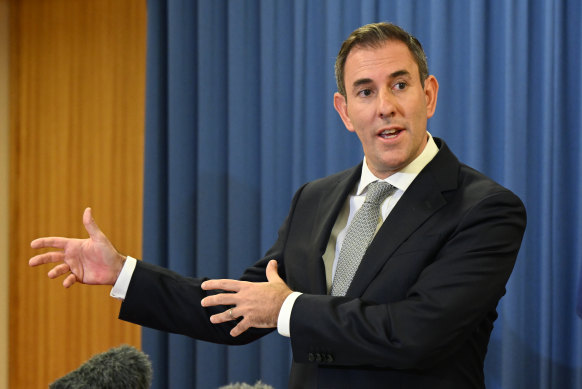By Shane Wright
The narrow economic path that the Reserve Bank and federal government have been walking for the past two years has just got even more slender.
In a setback to the bank, and the cause of a major political headache for Treasurer Jim Chalmers, the March quarter consumer price index report showed inflation is buried deep into parts of the economy with few signs it will be easily excised.

Jim Chalmers faces an even tougher May 14 budget after new inflation figures showed prices continuing to climb.Credit: Darren England
According to the Bureau of Statistics, consumer prices increased by a full percentage point through the first three months of the year. While annual inflation hit a 2½-year low of 3.6 per cent, it was the quarterly lift that will have grabbed the RBA.
Education inflation jumped to a 12-year high of 5.9 per cent, in part due to private schools raising their fees to start the new year.
In Sydney, education accounted for more than a quarter of the increase in inflation through the quarter. In Perth, which has a very deep private school sector, education caused more than a third of the city’s inflation.
But before you start taking your wrath out on the local private primary school, inflation was also driven by rents, which are now climbing at their fastest rate in 15 years. Sydney’s rent inflation has climbed by 8.9 per cent over the past 12 months. Two years ago, it had fallen by 1.2 per cent.
Insurance inflation is another huge problem, with prices up by a 23-year-high of 16.4 per cent.
As the bureau noted, this is being driven by higher reinsurance costs (which are set outside of Australia), the impact of natural disasters and overall claim costs, which are then feeding into premiums for houses, home contents and cars.
Prices are falling in some areas. Beef prices in Melbourne, for instance, fell by 5.2 per cent over the past year, while lamb prices tumbled by 17.6 per cent (the biggest annual drop in lamb chops since 1975).
Furniture, white goods and small electrical appliance prices are also falling, which indicates the slowdown in the economy can be measured in terms of worn-out lounges and leaky washing machines.
But dodgy furnishings and cheap chops are not nearly enough for the Reserve Bank, which has taken a vow of silence since mid-March. Neither governor Michele Bullock nor her new deputy, Andrew Hauser, have spoken publicly since the last board meeting on March 19.
Bullock will reappear for her press conference as governor on May 7 after the latest bank board meeting at which official interest rates will be held.
The days of hoping for interest rate relief mid-year are over. Those with a mortgage – who have borne the brunt of the RBA’s inflation campaign – can only pray that the bank isn’t minded that an economy that is only being kept out of recession by population growth needs another rate rise.
The problem, politically and economically, now falls on Chalmers and his May 14 budget. If the RBA thought it faced a narrow path to bring inflation down without wrecking the economy, Chalmers’ track is barely a few microns wide.
He has to find a way to ease inflation pressures, build economic capacity and lift productivity while simultaneously setting the government up for a run at the next election. And $23 billion worth of bipartisan tax cuts set to hit the economy from July 1 could inflame inflation.
Chalmers is going to need a good balancing pole to continue down this path.
Cut through the noise of federal politics with news, views and expert analysis. Subscribers can sign up to our weekly Inside Politics newsletter.